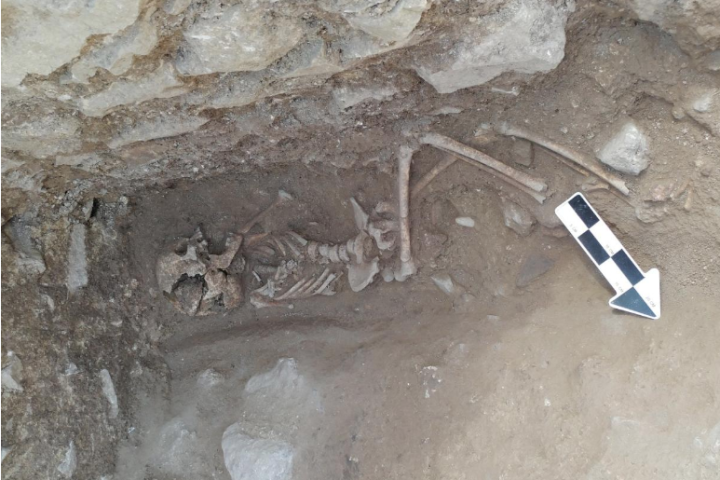Genetic analysis of bone fragments unearthed at an archaeological site in Germany shows conclusively that modern humans (Homo sapiens) reached northern Europe 45,000 years ago and that Neanderthals existed in the same region for several thousand years before they became extinct.
The findings reveal that the area near Ranis (Germany), known for its flaked leaf-shaped stone tool blades, is among the oldest confirmed sites of modern human Stone Age culture in north-central and north-western Europe.
Evidence that Homo sapiens and Homo neanderthalensis lived side by side is consistent with genomic evidence that the two species occasionally interbred. This also fuels the suspicion that the occupation of Europe and Asia by modern humans around 50,000 years ago led to the extinction of Neanderthals, who had inhabited the region for more than 500,000 years.
The stone blades at Ranis, called leaf-shaped blades, resemble stone tools found at various sites in Moravia, Poland, Germany and the United Kingdom. These tools, thought to have been produced by the same culture, are called the Lincombian-Ranisian-Jerzmanowician (LRJ) culture or techno-complex. Because of previous dating, the Ranis site was known to be 40,000 years old or older, but without recognisable bones to show who made the tools, it was unclear whether they were the product of Neanderthals or Homo sapiens.

“The new findings show that Homo sapiens made this technology and that Homo sapiens were this far north during this time period 45,000 years ago,” says Elena Zavala, one of the paper’s authors. So these were among the earliest Homo sapiens in Europe,” she says.
“The Ranis cave site provides evidence for the first expansion of Homo sapiens into the high latitudes of Europe,” says Professor Jean-Jacque Hublin. It turns out that the stone artefacts thought to have been produced by Neanderthals were actually part of the early Homo sapiens toolkit.”
“This fundamentally changes our previous knowledge of the period: Homo sapiens had reached north-western Europe long before Neanderthals disappeared from south-western Europe.”
Bones from maternal relatives?
Zavala carried out genetic analysis of hominid bone fragments from new and deeper excavations at Ranis between 2016 and 2022, and from earlier excavations in the 1930s. Because the DNA in the ancient bones was highly fragmented, he used specialised techniques to isolate and sequence DNA, all of which was only mitochondrial DNA (mtDNA) inherited from the mother.
“We confirmed that the skeletal fragments belong to Homo sapiens. Interestingly, several fragments shared the same mitochondrial DNA sequence, even from different excavations. This suggests that the fragments belong to the same individual or maternal relatives, and links these new finds to those from decades ago.”
The bone fragments were first identified as human by Dorothea Mylopotamitaki, a PhD student at the Collège de France, through the analysis of bone proteins, a field called palaeoproteomics.
By comparing mitochondrial DNA sequences from Ranis with mtDNA sequences from human remains at other Palaeolithic sites in Europe, Zavala was able to construct a family tree of early Homo sapiens across Europe. All but one of the 13 bone fragments found at Ranis were very similar to each other, and surprisingly similar to the mtDNA from a 43,000-year-old female skull discovered in a cave at Zlatý kůň in the Czech Republic. The only one that looked different was similar to a person from Italy.

“This raises some questions,” Zavala said: Was this a single population? What could be the relationship here? But in terms of mitochondrial DNA, this is only one side of history. This is only the maternal side. We need nuclear DNA to start investigating this.”
A transition area between the Middle and Upper Palaeolithic
Zavala is an expert in analysing DNA found in long-buried bones, bone tools and sediments. In his research on sediments from various levels of the Ranis excavation, DNA was recovered from a wide variety of mammals, but none from hominids.
The analysis, combined with morphological, isotopic and proteomic analysis of bone fragments, paints a picture of the environment at the time and the diet of both humans and animals that inhabited the cave for thousands of years.
The presence of reindeer, cave bear, woolly rhinoceros and horse bones, for example, indicated a cold climate typical of the steppe tundra and similar to conditions in present-day Siberia and northern Scandinavia, and a human diet based on large land animals. The researchers concluded that the cave was primarily used by hibernating cave bears and hyenas, with only periodic human presence.
These low-density archaeological remains match other Lincombian-Ranisian-Jerzmanowician sites and are best explained by short-term purposeful visits by small, mobile groups of pioneer Homo sapiens.
Sarah Pederzani, who led the palaeoclimate study of the region, said: “The findings show that even these first groups of Homo sapiens, dispersed across Eurasia, already had the capacity to adapt to such harsh climatic conditions. Until recently, it was thought that resilience to cold climatic conditions did not emerge until several thousand years later, so this is a very impressive and surprising result.”
The Ranis site was first excavated between 1932 and 1938. The leaf-shaped tips found here were attributed to the last years of the Middle Palaeolithic period (about 300,000 to 30,000 years ago) or the beginning of the Upper Palaeolithic period, which began about 50,000 years ago.

Due to the importance of the Ranis site for understanding the transition from the late Middle Palaeolithic associated with the LRJ technocomplex and Neanderthals to the modern human Upper Palaeolithic in Central Europe, the researchers decided to re-excavate the site using the modern tools of archaeology.
The new excavations extended to bedrock about 8 metres below the surface and included the removal of a boulder that had probably fallen from the cave ceiling, halting previous excavation. Here Hublin’s team uncovered fragments of flint tools and a quartzite flake consistent with the LRJ technocomplex.
Subsequent proteomic analysis of thousands of bone fragments confirmed that four were from hominids. Nine of the bone fragments unearthed during excavations in the 1930s belonged to hominids. Zavala’s DNA analysis confirmed that all 13 bone fragments were from Homo sapiens.
Revised settlement history of northern Europe
The team also carried out radiocarbon dating of human and animal bones from different layers to reconstruct the chronology of the site, focusing on bones that bear traces of human modifications on their surfaces and link their history to the human presence in the cave.
“We found very good agreement between the radiocarbon dates of Homo sapiens bones from the excavation collections and the modified animal bones from the LRJ layers of the new excavation, which creates a very strong link between the human remains and the LRJ,” says co-author Helen Fewlass.
Evidence suggests that Homo sapiens has inhabited this area sporadically since 47,500 years ago.
“The results obtained at Ranis have fundamentally changed our ideas about the chronology and settlement history of Europe north of the Alps.”
Article 1: : Jean-Jacques Hublin. (2024). Homo sapiens reached the higher latitudes of Europe by 45,000 years ago. Nature.
Article 2: Pederzani, S., Britton, K., Trost, M. et al. (2024). Stable isotopes show Homo sapiens dispersed into cold steppes ~45,000 years ago at Ilsenhöhle in Ranis, Germany. Nat Ecol Evol.
Article3: Smith, G.M., Ruebens, K., Zavala, E.I. et al. (2024). The ecology, subsistence and diet of ~45,000-year-old Homo sapiens at Ilsenhöhle in Ranis, Germany. Nat Ecol Evol.
Article 4: William E. Banks. (2024). Stone tools in northern Europe made by Homo sapiens 45,000 years ago. Nature.





